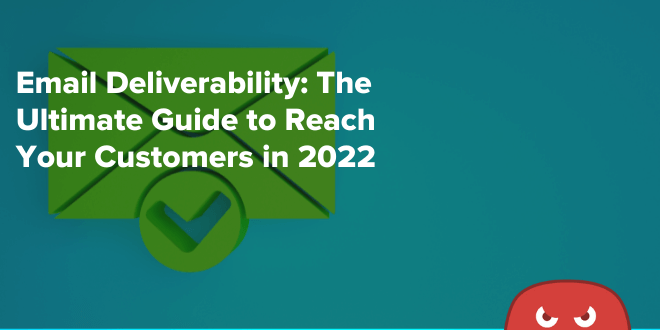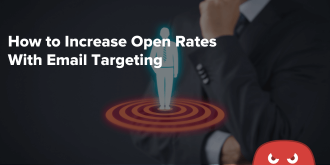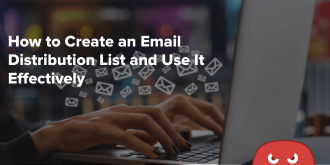Quick Links
Email marketing is one of the best channels for reaching your audience and gaining conversions. On average, email has an ROI of $36 for every dollar spent — better than any other form of marketing.
But, that doesn’t mean email marketing is easy. Marketers have tons of email metrics they can use to measure a campaign’s performance. Among the most important of these metrics is email deliverability.
This metric measures if your emails are reaching your subscribers’ inboxes or if they’re just ending up in spam folders.
To help you gain a better understanding of email deliverability, we break down exactly what it is, why it’s important, and how to improve your deliverability in this article.
What is Email Deliverability?
Email deliverability is the ability of your promotional emails to reach the recipient’s inbox. It’s a complex metric showing you the quality of your email lists and email campaigns.
You can measure your email deliverability by looking at your inbox placement rate. It’s the number of emails delivered to the inbox out of the total emails sent.
The terms email deliverability and email delivery rate are not interchangeable — an email may be delivered but marked as spam and thus discarded. Inbox placement rate gives a more accurate picture.
Less than 20% of marketers can brag about having a 90% or higher inbox placement rate. The rates of 89–69% are far more common. But the average spam rate is only 0.01%, so it’s not the picky users that don’t want to receive any commercial emails.
It’s marketers not ensuring their email deliverability before hitting “send.”
The three elements of email deliverability
There are several external and internal factors that influence your deliverability rate. It all boils down to what you are sending, how you are sending it, and who you are sending it to.
These are the three key elements of email deliverability:
- Relevant and optimized email content: Bulky or clickbaity emails have a lower chance of landing in the inbox and being opened.
- Safety and sender reputation: Email services flag or filter out emails from unauthenticated or compromised domains.
- Engaged audience: Your recipients have to express consent and be interested in getting emails from you. Otherwise, they’ll ignore or report your messages.
Now, let’s dig a bit deeper.
Why Should You Care About Email Deliverability?
It’s frustrating to pour your efforts into an email campaign just to find out that it was ghosted by your target audience. But there’s more to it than mere sentimentality. Improved email deliverability can benefit your business on many levels.
#1. Strengthen your customer relationships
Ensure smooth, interruption-free communication with your customers to boost their interest and loyalty to your business.
Did you know that 37% of consumers prefer hearing from their favorite brands over email? Also, more than half of shoppers say that they look for seamless and personalized interactions with businesses.
Combine these two, and you’ll get a solid chance to generate repeat customers and devoted brand fans who would enjoy regularly receiving your email campaigns.
#2. Beat your competitors
Email is considered one of the most competitive and valuable channels — nine out of ten marketers use it to distribute content.
So, businesses can’t afford to treat it casually. By working on your email deliverability, you prevent your competitors from outpacing you.
Mastering email deliverability doesn’t require big investments or highly technical skills — it’s more about paying attention to details. And by doing that, you can succeed where others may fall short.
#3. Get higher ROI
When your email deliverability is lagging behind, it’s slowly turning your email marketing into a money-sucking machine. You’re forced to spend time and money on developing and setting up campaigns, email tools, and content creation, but you don’t get your investments back.
Improving email deliverability means improving ROI and gradually freeing up the resources needed for growth. You get a clearer picture of how your core audience reacts to your emails and what you can do to monetize their interest.
Common Factors That Hurt Your Email Deliverability
Here’s a list of the factors that are extremely likely to harm your inbox placement rate:
- Single opt-ins: If visitors can just sign up to your list through the form without having to confirm their subscription, spammers and fake-email users will take advantage of it and ruin the quality of your email list.
- No dedicated sending domain: Sending emails from a general domain everyone in your company uses isn’t recommended since you can’t control your sender reputation.
- High bounce rates: A high number of rejected or flagged emails tells email service providers that you have a low-quality email list that may have been bought or stolen.
- No custom authentication: Email users and service providers prefer to deal with senders who care about safety and are ready to go the extra mile to prove their legitimacy.
- Unclear unsubscribe options: If you don’t leave your subscribers an option to stop receiving your campaigns in one click, they’ll feel cornered and most likely mark your emails as spam.
- Image-heavy emails: Spam filters don’t like suspiciously heavy emails because they are more likely to carry malicious attachments.
- Spikes in email traffic volume: An unnaturally high sending volume from a previously inactive domain is an absolute red flag — email services expect commercial senders to grow their numbers gradually.
- Lack of personalization: Customers grow weary of generic marketing emails that have nothing to do with their real needs and simply stop opening or engaging with them.
- Repeat complaints: If you keep sending emails your recipients mark unsolicited, email service providers will do everything to lower the number of inboxes your campaigns reach.
- Poor engagement: The fact that your current emails are being ignored by your audience can negatively influence the deliverability of your future campaigns.
- URL shorteners: Shrinked, hard-to-read URLs are often used by scammers — that’s why they can make an otherwise legit email end up in the spam folder.
- No-reply email address: If your customers see that they can’t reply to your emails, they’ll quickly lose interest in one-way communication with your business.
Chances are, you ticked at least one of the boxes. But there’s no need to worry — we’ll address these and other issues and discuss how to fix poor email deliverability.
How to Boost Your Email Deliverability
We’ve briefly touched on five key areas that impact email deliverability rates:
- Sender reputation: What email service providers “think” of your sending domain.
- Authentication: How you prove that your emails are authentic and not forged or spoofed.
- Content: What you put in your emails and subject lines.
- Logistics: How you deliver your messages.
- Audience: How your recipients interact with your emails.
Just a heads up, all of these areas are interconnected — so by improving, say, your opt-in strategy, you’ll also positively influence your sending reputation.
Let’s unpack each of them and see how you can improve these areas, step by step.
#1. Sender reputation
Your ability to reach the inbox depends on the reputation of your domain and the IP addresses associated with it. Email services score them based on your sending volume, whether they’ve been blacklisted, and so on. High unsubscribe rates, spam reports, bounce rates, and engagement rates also play a big role.
Here are some tips to improve your sender reputation:
- Regularly monitor your IP reputation using tools like SenderScore.
- Adopt an email list hygiene routine and remove invalid addresses and subscribers who haven’t reacted to your emails for months.
- Develop sending consistency over time and gradually increase your sending volume instead of taking an “all or nothing” approach.
- Reduce spam complaints by making sure you send only solicited and personalized emails.
- Avoid spam traps by validating new email addresses before starting sending them campaigns, especially if there’s a sudden surge in email subscriber conversions.
- Prevent blacklisting by making sure everyone in your company vigorously sticks to these tips.
#2. Authentication
Authentication is your way of showing email service providers and your recipients that you are a trustworthy sender and that your emails aren’t forged or spoofed.
There are three ways to make it happen.
SPF
Verify your sending domain via SPF (Sender Policy Framework). This framework allows you to authenticate domains that you or your business own and control.
For that, you need to create an SPF record — a list of servers that can send emails from your domain and instructions on how to handle requests from your domain.
To find or create an SPF record, you need to follow the instructions from your email software provider. If you can’t find them, contact their support. Then, you’ll have to add that record to your domain TXT records. If you don’t know where your DNS records are located, reach out to the person that manages your website or email address for help.
By adding an SPF record, you vouch for your emails’ authenticity. That’s how you tell email services who’s allowed to send messages on your company’s behalf.
DKIM
Use DKIM (DomainKeys Identified Mail) to digitally sign your emails in a way that can be verified by your recipients or, more precisely, their email services.
DKIM consists of two elements: the DKIM record, which is stored in your domain records, and the DKIM header, which is attached to the emails you send from that domain. You, as a sender, get a private key to sign your outgoing messages, and your recipient gets a public key to verify your signatures.
This signature verification process works like a seal — it helps both parties ensure that your emails have actually been sent by you or your company and have not been changed in transit.
Encryption
Commercial emails may contain sensitive customer data such as their contact information, address, or order details. To prevent email data breaches, check whether the email software of your choice supports email encryption.
More often than not, services like Zoho Mail or Sendinblue support TLS (Transport Layer Security) encryption that prevents unauthorized access to an email when it’s in transit, but only if the recipient server supports TLS.
If the other server doesn’t support TLS, your email will be delivered using a standard SMTP protocol.
#3. Content
When your email content doesn’t match your subscribers’ expectations and needs, you get a drop in engagement and, subsequently, lower email deliverability. Spam filters can also penalize you for sharing unsolicited or suspicious content — even if you had no intentions to spam.
Here are some potential cures:
- Create personalized and relevant content. Use advanced audience segmentation and dynamic content in your email campaigns to press all the right buttons.
- Perfect your email layout. Create a clear visual hierarchy, break your layout into easily scannable chunks, and sprinkle it with a moderate amount of CTA buttons.
- Prioritize mobile-friendly design. Make sure your emails are easy to read, even during a hectic commute.
- Go easy on large file attachments. Email service providers want to prevent their users’ inboxes from being overloaded, so they may filter out especially bulky emails.
- Keep a reasonable text-to-image ratio. Fully image-based emails can also be considered spammy, even if they contain some text. It’s better to maintain a 60/40 ratio or something along those lines.
- Avoid spammy subject lines and all caps. A clickbait-like message is an immediate red flag for any email service filtering system.
- Run A/B testing. Test different images, layouts, and buttons to find the right formula and increase your open rate.
Need some help creating better content for your emails and website? HOTH Blogger can help.
#4. Logistics
The way you deliver your messages matters. Make sure to follow these tried-and-true practices if you want to give your email deliverability a boost.
Choose dedicated domains and IP addresses when you can
Use dedicated domains instead of free or personal email addresses. A custom domain immediately creates a professional impression, but it’s not just that. If your company sends all sorts of messages from the same domain, its reputation will eventually suffer.
When you use a dedicated domain for your marketing communications, only your practices determine your sending reputation. And you gain more control over your inbox placement rate. The same is true for IP addresses, although to a lesser extent.
A dedicated IP is easier to whitelist. Also, using it means having sole responsibility for DNS records. But you don’t need to invest in a dedicated IP if you are a very small business — mistakes will also cost you more, and there won’t be enough sending volume to even them out.
Include a plain text version
Provide your email subscribers with a great user experience in both your HTML and plain text emails — it’ll incentivize them to always open messages from you. Including a plain text version may also help your email avoid the spam folder since spam messages often don’t have a plain text version.
Plain text is more accessible to screen readers. It looks more natural, almost hand-written, which makes your email communications feel less commercial. Also, this format allows you to display all your links and paragraphs correctly if your recipient’s app can’t show the HTML version of your email.
Be wary of URL shorteners
Shortened links can harm your email deliverability, and here’s why. Scammers often use them to direct users to phishing websites and spread malware. Since all shortened links look somewhat similar, it’s harder for the user to figure out where such link leads.
Naturally, email users and providers grow suspicious of shortened URLs. It’s always better to let your subscribers know what to expect if they click your link. If you absolutely must use a shortened link, consider providing some context, or using your email marketing platform’s link shortening or tracking options.
Stay away from no-reply email addresses
For starters, your subscribers can simply auto-filter no-reply emails as spam in their inbox. This alone can dramatically affect your email deliverability rate. Also, emails from no-reply addresses are more likely to be caught by spam filters.
Besides, a no-reply email address indicates a lack of interest from your side, which is not something customers feel drawn to. What if a recipient tries to reply to your email? They’ll immediately see that your business isn’t approachable even though you do try to communicate with them. It will only confuse or annoy them.
Always use a real email address your subscribers can send a message to. It’ll empower them to engage with your emails in a more meaningful way. As a result, your email deliverability rate will go up.
Set up an email feedback loop
A feedback loop is when your email service provider notifies you whenever your recipient reports your email as spam. This process lets you clean and update your mailing list regularly and keep your sending reputation intact.
Some email services may send you the details of each spam complaint, while others provide more aggregate data that doesn’t say who specifically filed complaints.
You can find a third-party service that will do most of the work for you by checking the recipient’s email address and making sure it’s not on the so-called suppression list. If it is, the system will refuse to send them emails.
#5. Audience
This part is pretty straightforward. Treat your subscribers nicely, and you’ll get a natural email deliverability improvement over time because they won’t be able to get enough of your content.
Here are some details worth paying attention to:
- Use double opt-ins to attract an interested, active audience and validate their addresses on the spot. Building your mailing list will take longer, but it’ll be a higher quality audience.
- Segment your email campaigns to avoid overwhelming your subscribers with information they may not need.
- Make the unsubscribe link visually accessible. It’ll help your recipients pause or stop your campaigns without having to block or report you.
- Regularly “prune” your emails to get rid of inactive subscribers and avoid getting flagged for spam.
Improve Your Email Marketing Game
As you can see, creating a great email campaign is only half the battle. Taking care of email deliverability is just as important because that’s how you make sure your words reach your customers’ ears, or, in this case, eyes.
If you want to guarantee that your content is seen and heard well beyond your existing circle, consider trying HOTH Web Copy. That’s your one-stop shop for quality content that search engines love — we will create engaging copy for your website and landing pages to help you drive conversions and rank higher on Google.
















I’m really satisfied about your manner of communicatiing this important aspect of deliverabiity aout my emais.
Once more thanks about about this important topic.Thanks again.l
Nice Blog Thank You For Sharing.
Very detailed resource for email marketing, especially key to have all the dns records in place to secure your domain and avoid going straight to spam.
More informative article. The email marketing way is very effective marketing method
Thanks about about this important topic.
Amazing Blog. I really Liked the the Designs.
Very informative article .Thanks for sharing ✨